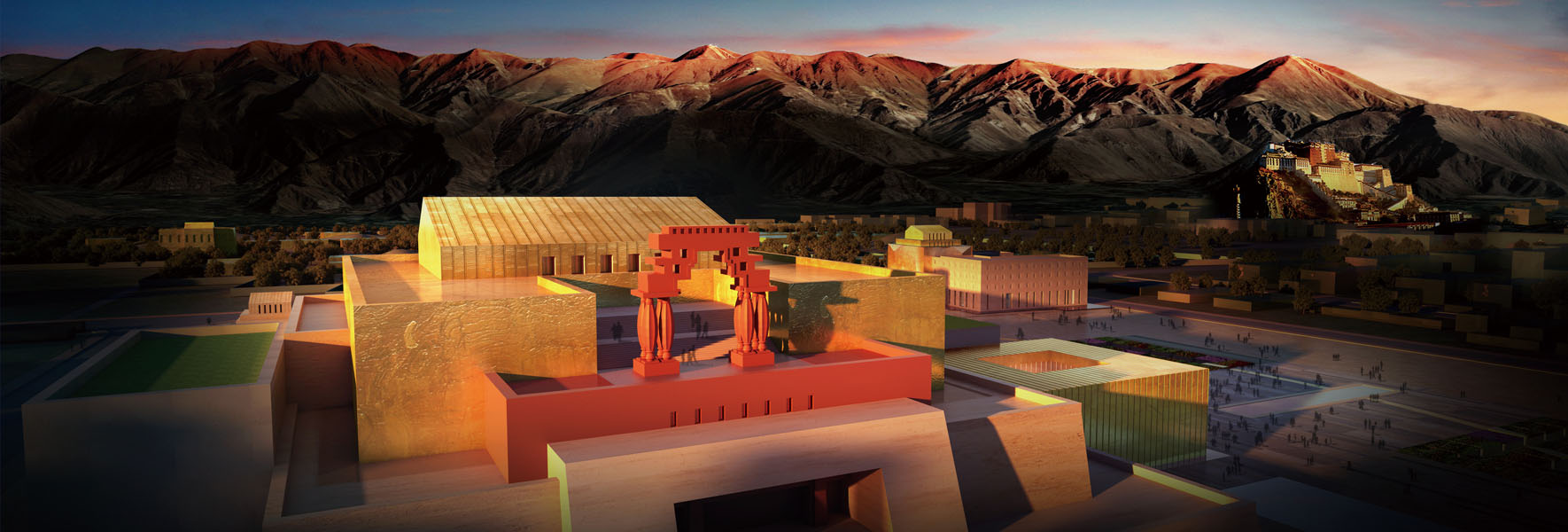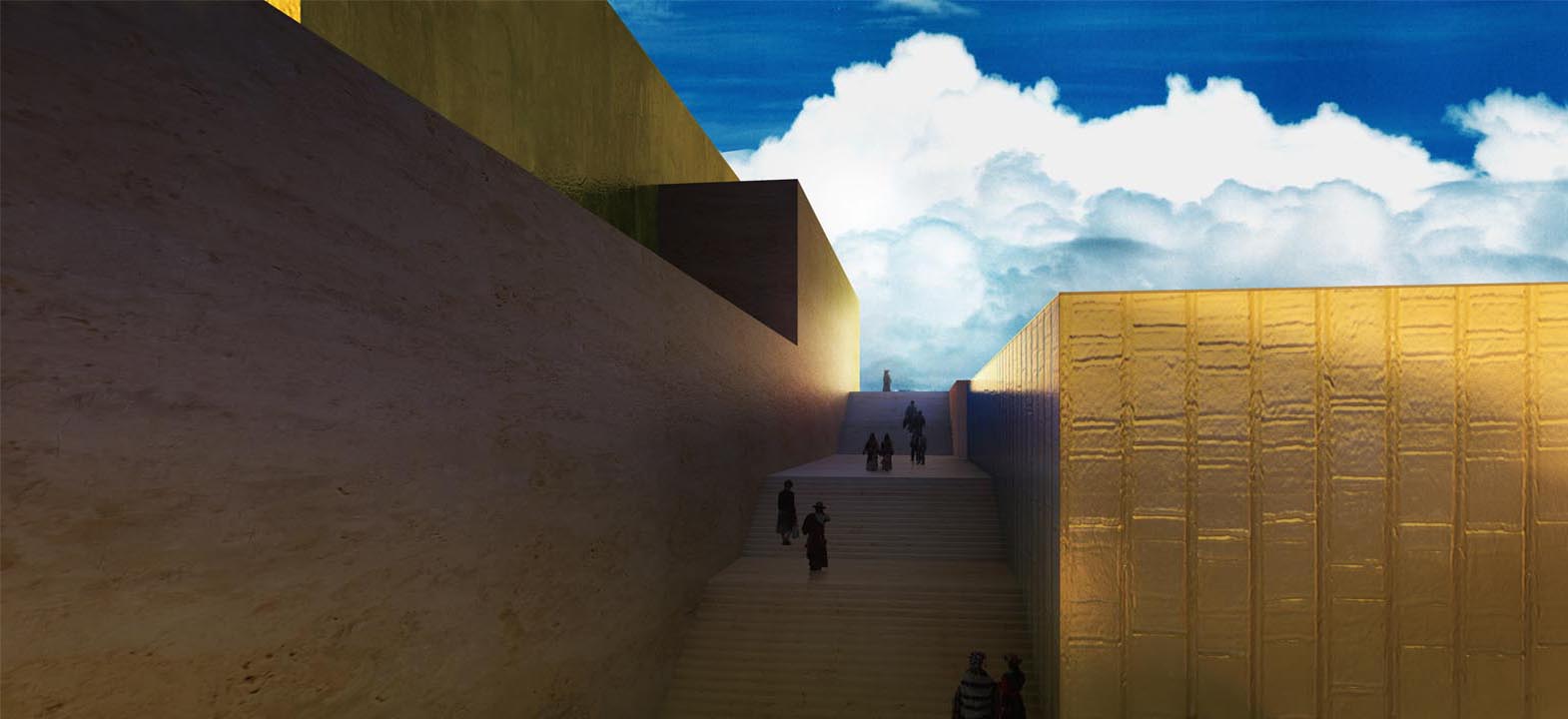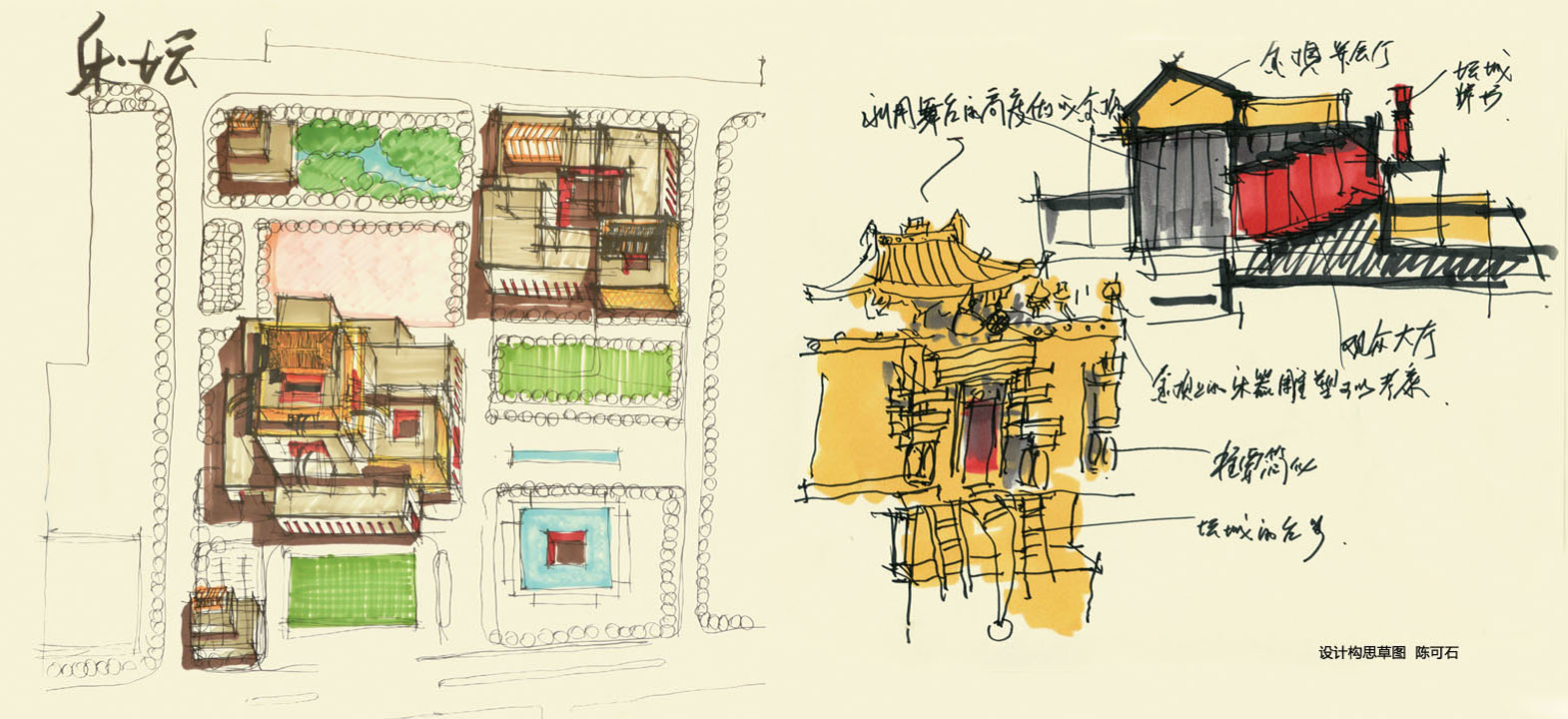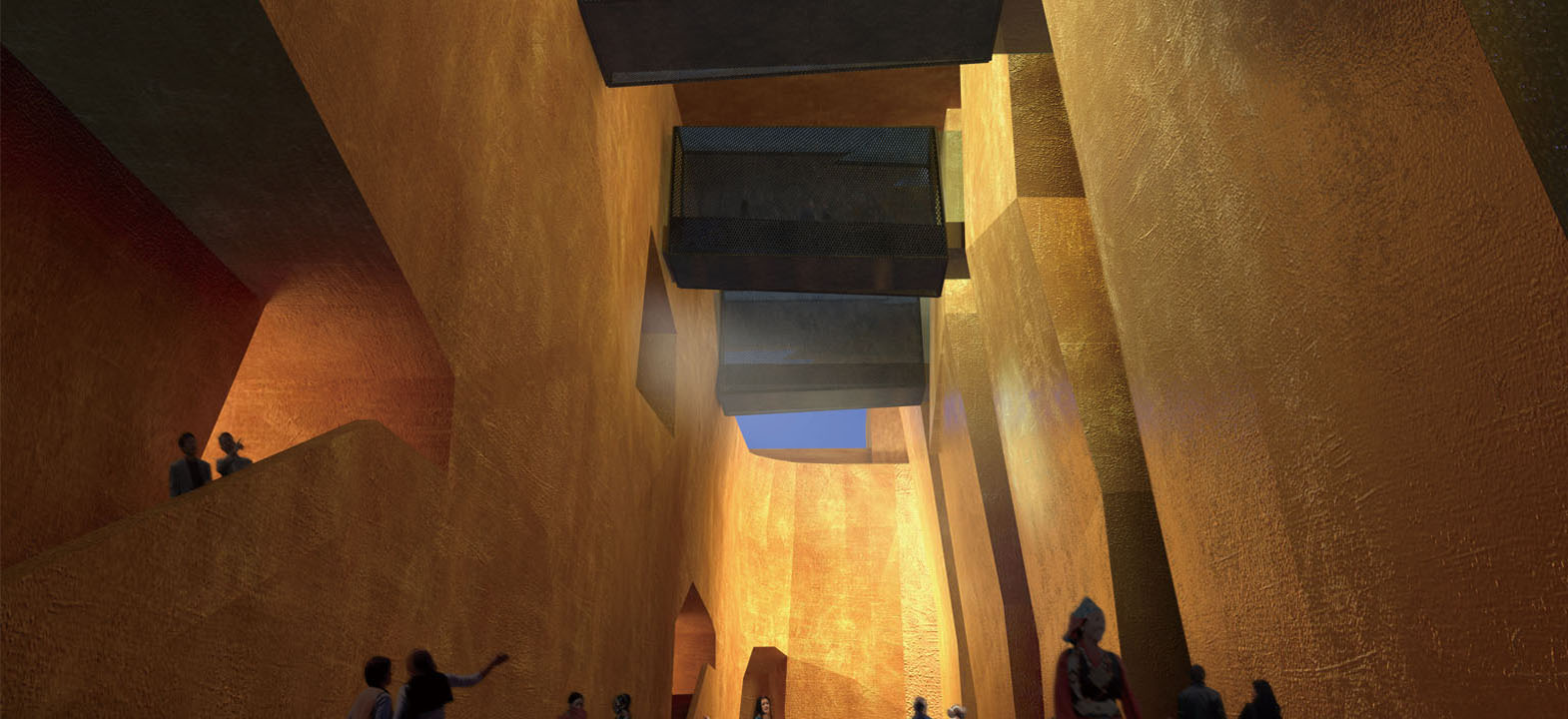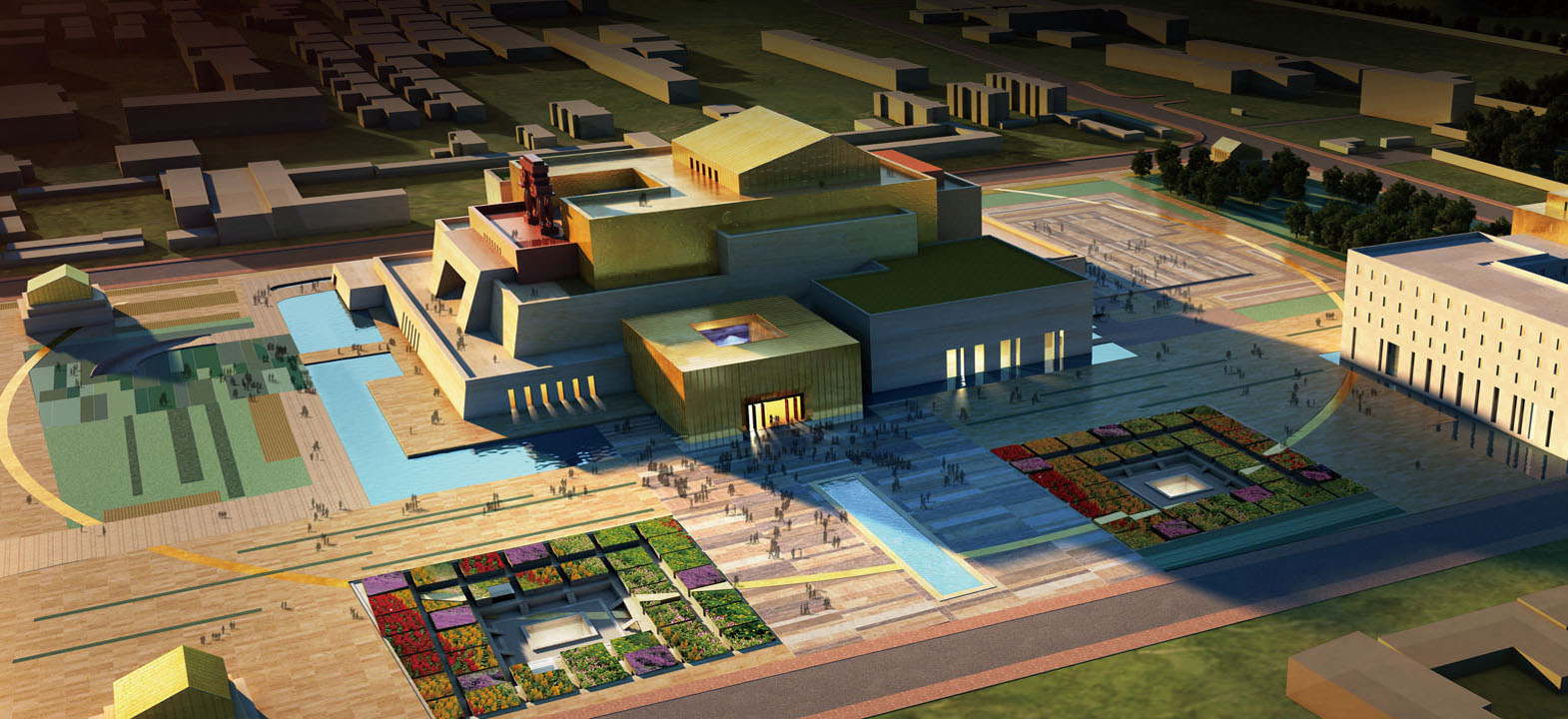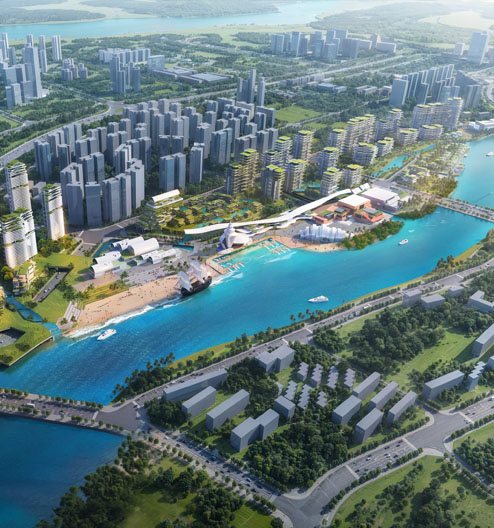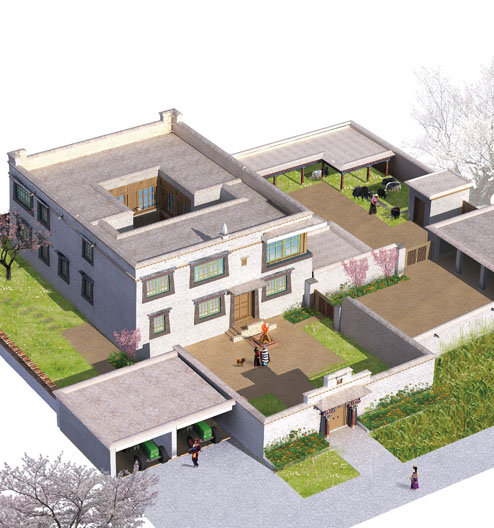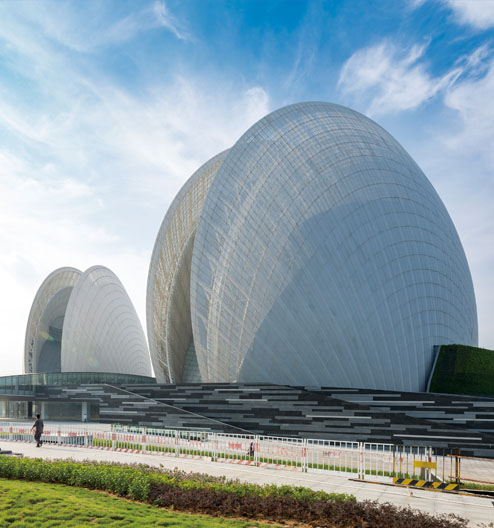Tibet Grand Theater
The golden music world - Tibet Grand Theatre is located in the west of Lhasa city, Jinzhuxi road, adjacent to Norpulingkha, about 2.7 km away from the Potala Palace in the east, and about 4 km away from the Jokhang Temple. It is the first provincial standard grand theatre in Lhasa, representing the new urban culture in Lhasa, the material display of contemporary culture and art in Tibet, and the intersection of daily life and world tourism. In the future, it will be well integrated into the inherent cultural system of Lhasa, closely connected with the original spiritual core space such as Potala Palace, Jokhang Temple, and Norpulingkha, and skillfully connect the cultural stories of Tibet through the deep understanding of Lhasa's land and the unique design method, to become the new spiritual core of Lhasa and the new landmark of Tibet's contemporary culture and art.
The total land area of the project is 69,000 m2, with a total construction area of 49,000 m2, of which the main building unit, the comprehensive art center (Tibet Grand Theater) covers an area of 34,463 m2, and the supporting architectural art hotel covers an area of 8,500 m2.
Prof. Chen Keshi and his team established the "golden music world" as the core brand of Tibet Grand Theater project through an in-depth study of Tibet's natural geography and human geography, combined with Tibet's traditional architecture. "Gold" is the noblest Tibetan architectural material, the most typical Tibetan architectural element, and the most fashionable modern aesthetic in Tibet; "music" represents the most joyful Tibetan song and dance, the most mysterious Tibetan drama, and the most charming Tibetan Mandala. "Golden music world" will become the largest art center, the latest living room and the most important new name card of modern Tibet.
The inspiration for the golden music world comes from the intention of "Mandala" in Tibetan culture. In Tibet's traditional cosmology of thousands of years, "Mandala" is the center of the world, Shambhala and the heaven of joy. In the golden music world, the golden roof is the core of "Mandala". According to the intention of "Mandala", the plan cleverly uses the architectural space with different functions to build a modern Tibetan art paradise - golden music world, which is a modern interpretation of the traditional Mandala.
The first design principle of the grand theater and hotel is the practicability, economy and function rationality of the building. As the main part of the whole building, the grand theatre is arranged in the center of the building. Based on the reasonable layout of the stage, performance and other main spaces, architectural design combs the location of auxiliary function spaces such as backstage, service and so on, forming a large theater building with reasonable and practical functions.
The golden hall is located on the east side of the building. It is the main entrance of the audience and undertakes the function of a comprehensive reception. The concave Tibetan traditional gate and the two sides sloped walls form a unique entrance space. In the lobby, the surrounding and layout are adopted, facing the main entrance is the information office, behind which a picture full of Tibetan style is designed. The walls on both sides are made of gold metal plates with Tibetan language.
Jinding restaurant (banquet hall) is located on the top floor of the building, which is the visual focus of the whole plot. Jinding restaurant represents the modern revival of Lhasa's traditional art and is the new name card of Tibet. The location of Jinding restaurant can be seen from the Potala Palace, Jokhang Temple, Norpulingkha and Lhasa River, highlighting its superior geographical environment and excellent landscape sight.
The biggest characteristic of Tibetan traditional architecture lies in its strong regionality. Blue sky, white cloud, wilderness and snow mountain, Tibet's unique natural conditions and customs create a unique Tibetan traditional architectural language, showing respect for nature and heritage of history.
Regionality is the modern expression of the Tibetan architectural language. Like growing out of Tibet, the golden music world is unique and has its roots. This uniqueness is the reason why the golden music world can create the greatest artistic value for the city.
The regional features are also reflected in the use of local materials and traditional colors, including gold foil, rammed earth, stone, wood carving and the most representative five colors of Tibetan traditional architecture - gold, red, white, black and earth yellow. The design of golden music world reflects the characteristics of Tibet's natural geography, and the use of natural ventilation is one of the key points of interior design; as an outdoor corridor of communication and leisure space, the use of gray space treatment reflects the design's consideration of local climate characteristics.
The overall architectural design reflects the characteristics of the traditional Tibetan architecture, which is solid and stable in structure and diverse in form. The building adopts the sloped wall, which is wide at the bottom and narrow at the top, so as to reduce the center of gravity of the building; the wall thickness is increased appropriately to maintain the stability of the building, which makes the grand theater show its unique regional characteristics.
The originality of modern architecture, especially for theatre architecture, is the most important topic. The golden music world will become a unique architectural masterpiece in the world because originality is its most important design concept. The mandala represents the design concept of Tibetan traditional architecture. In Tibetan tradition, "Mandala" is a religious ideal country, and the golden music world will become an ideal realm of Tibetan contemporary art.
Artistry is the greatest pursuit of theater architecture. Theater architecture itself is a great artwork, and the artistic appeal of spiritual space is the charm of Tibetan architecture. The golden music world highlights four artistic elements of Tibetan traditional architecture:
Light the biggest highlight of Tibet's artistic elements is light and shadow. The golden music world uses light to shape the building shape and express the magnificent beauty of the building; the interior design adopts the top light commonly used in Tibet's traditional buildings, which creates the unique mysterious and holy architectural artistic effect in Tibet. The four sides of the roof of the golden hall are provided with strip skylights. The sunlight is sprinkled on the black reflective floor through the skylight and reflected other places in the building. In the center of the roof is a white prayer flag that has been interpreted in modern approach. The contrast between the dark and the white in the whole hall enhances the mystery and richness of the space.
Color the most striking architectural element in Tibet is gold. The golden roofs, statues and ornaments of Potala Palace and Jokhang Temple create a "resplendentt" artistic effect. Gold has the intention of "precious", "rich" and "top". Gold foil is also the highest level of building material in Tibetan architecture. The golden music world first uses gold as the main color of the building, and then the earthy yellow, red, black and white. The earth yellow is the color of rammed earth wall, which is the most commonly, used color in Tibetan folk; the red is a noble color, and the main colors of red and black are used in the interior design of golden music arena; the white is the color of stone, which is also the symbol of modern architecture. The building base adopts a white gray marble to express the most modern architectural temperament of the golden music world.
Space the carrier of Tibetan architectural art and the most mysterious part of Tibetan traditional architectural art. Under the influence of light and color, the traditional architectural art space in Tibet shows magnificent, lofty and mysterious artistic effects. With modern architectural space, combined with light and materials, golden music creates the artistic charm of modern Tibetan architectural space. Especially in the design of interior space, the space treatment of Jinding banquet hall, grand theater, art gallery, small theater and golden hall all highlights the artistry of Tibet's modern space design.
Totem Tibet's decoration uses a wealth of totems, especially in interior decoration, doors, windows, columns, totems can be seen everywhere. The design of the golden music arena takes the modern sense into account, so it does not emphasize the use of traditional architectural totem, but uses a "Mandala archway" as the abstract expression of Tibetan "Mandala" totem, making it as a bridge connecting the traditional and modern, becoming the symbol of the grand theater architecture.
Golden roof highlights its lofty position
Jinding (golden roof structure) is the highest form of Tibet's traditional architecture and the loftiest symbol of Tibet's contemporary architectural art. In Lhasa, the Potala Palace, Jokhang Temple, and Norpulingkha all use gold roofs to highlight their high status in the city. The golden top of the golden music circle is the loftiest symbol of the new architecture in Tibet.
The Jingding is made of gold foil, brass, metal plate, imitation gold brick, and other building materials. Jinding consists of two parts; one is the Jinding restaurant and banquet hall, which is directly accessible by a special elevator. It is the place for local citizens and tourists to entertain the most distinguished guests in the future. The other part is the sightseeing platform over the Grand Theater - "Mandala archway". The gold foil on the wall of the Grand Theatre is engraved with Tibetan and Chinese long poems and songs. In the evening, overlooking the Potala Palace and Lhasa River on the platform of Jinding will become an important festival for Lhasa Tourism.
The art hotel provides accommodation for performing artists from all over the world. The design of the art Hotel is the continuation of the design concept and artistic essence of the Grand Theater. They echo each other and complement each other in terms of architectural intention, form, function and spatial form. The hotel continues to follow image of "Mandala", adopts the way of geometric shape around the atrium layout, and refers to the design of the Grand Theatre in the selection of architectural style and materials, and together with the Grand Theatre, it forms the architectural complex and city square of golden music arena.
The green concept comes from the traditional buildings in Tibet, which care about the natural environment, save resources, and select the most economical structural form according to the functional needs to reduce the cost. The building of the golden music arena adopts the simplest mixed structure of steel structure and concrete structure, which is convenient for prefabrication and field installation, to shorten the construction time.
The external landscape design continues the concept image of "Mandala" and abstracts it. Combined with the function, the two main landscape functional areas of the city square and open-air theater are formed. The dynamic and static are combined, and the scale is corresponding. At the same time, it pays attention to the extraction of landscape elements from traditional Tibetan art for modern interpretation, such as the use of horizontal and vertical lines in plant landscaping, combined with tree array layout, and the use of strip texture extracted from traditional Tibetan clothing as landscape elements in pavement, showing a coordinated style and different functions of landscape features. At the same time, the water system is used to connect the individual buildings to form a vivid and poetic landscape effect, and the circle elements extracted from the altar city are designed to connect the landscape elements in the site to form a visual whole, to meet the leisure and gathering functions of the site and the needs of recreation and sightseeing, at the same time, create a modern landscape with unique Tibetan charm, and make it become the public cultural square, the artistic living room, and the romantic interpretation place of Tibetan culture.
